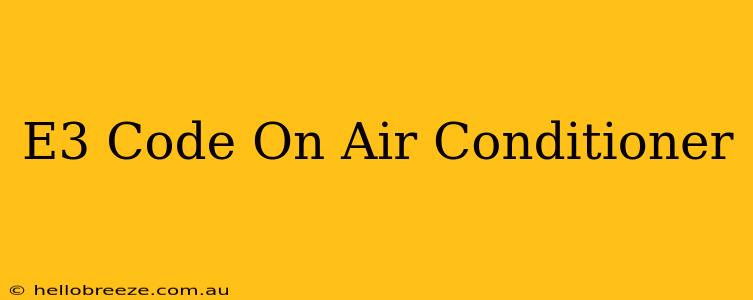Is your air conditioner displaying an error code E3? Don't panic! This common error code often points to a solvable issue. This guide will walk you through understanding the E3 error, diagnosing the problem, and finding solutions to get your AC back up and running smoothly. We'll cover potential causes, troubleshooting steps, and when it's time to call a professional.
What Does the E3 Error Code Mean?
The E3 error code on your air conditioner varies slightly depending on the brand and model. However, it generally indicates a problem with the communication between the indoor and outdoor units. This crucial communication is essential for the proper functioning of your AC system. A disruption in this communication can lead to the system shutting down to prevent further damage.
Common causes of the E3 error include:
- Wiring issues: Loose, damaged, or corroded wiring between the indoor and outdoor units.
- Faulty control board: Problems with either the indoor or outdoor unit's control board, which manages communication.
- Sensor problems: Malfunctioning sensors in either unit that are responsible for relaying information.
- Refrigerant leaks: In some cases, a refrigerant leak can indirectly trigger an E3 error.
Troubleshooting Your E3 Air Conditioner Error
Before you call a repair technician, try these troubleshooting steps:
1. Check the Wiring Connections
- Power Down: Begin by turning off the power to your air conditioner at the breaker box. Safety first!
- Inspect Wiring: Carefully inspect all wiring connections between the indoor and outdoor units. Look for any loose, damaged, or corroded wires. Pay close attention to connections at the terminals.
- Secure Connections: If you find loose connections, carefully tighten them. If wires are damaged, replace them immediately. Never attempt repairs if you are not comfortable working with electrical wiring.
2. Examine the Control Boards
- Visual Inspection: Visually inspect the control boards in both the indoor and outdoor units. Look for any signs of damage, such as burn marks or loose components.
- Clean the Boards (If Safe): If you're comfortable doing so, gently clean the boards with compressed air to remove dust and debris. Again, if you're unsure, skip this step.
3. Check the Sensors
Locating and testing sensors requires specific knowledge about your air conditioner model. It's best to consult your user manual or seek professional assistance for this step.
4. Consider Refrigerant Levels (Advanced)
Checking refrigerant levels is an advanced troubleshooting step and should only be attempted by qualified technicians. Low refrigerant can cause various problems, sometimes leading to error codes.
When to Call a Professional HVAC Technician
If the simple troubleshooting steps above don't resolve the E3 error, it's best to contact a qualified HVAC technician. Attempting more advanced repairs without the proper knowledge and tools can lead to further damage and potentially void any warranties. A professional will have the necessary expertise and equipment to accurately diagnose and fix the issue, ensuring the safe and efficient operation of your air conditioner.
Remember: Safety should always be your top priority. If you're unsure about any of these steps, it's always best to err on the side of caution and call a qualified professional. An E3 error code, while often fixable, shouldn't be ignored. Getting your air conditioner repaired promptly ensures your comfort and prevents potential future problems.

